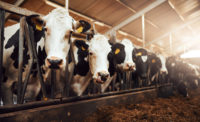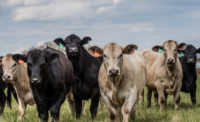Processing Tech
Effective humane stunning

Of the many processes necessary to take a live animal and convert it to meat suitable for the dinner table, the kill step has long been the most controversial. Even consumers who eat meat on a daily basis may be somewhat uncomfortable with the slaughter of a live animal and would prefer to think that it died painlessly and humanely.
Some anti-meat activists have taken advantage of the consumers’ concern for animal welfare by alleging that the stunning process prior to the kill step is ineffective. Several undercover videos taken at poultry or hog processing plants have used the convulsions of stunned animals as evidence that the animals were alive and in pain as they were bled out. Those arguments may be compelling to consumers who don’t know about the industry, but the science behind stunning shows that the process works like it should.
“As far as we can tell, electrical stunning and mechanical stunning methods — which include captive bolt and firearms — cause an immediate loss of consciousness for the animal,” explains Kurt Vogel, Ph.D., assistant professor of animal science at the University of Wisconsin – River Falls. “Following the application of any stunning method, involuntary movements are expected from the animal’s body. When both electric and mechanical stunning systems are operated and maintained appropriately, they are highly effective.”
Like any system in a processing plant, the stunning systems need to be monitored. Professor Shai Barbut of the University of Guelph recommends the stunning line be monitored by employees to make sure the hogs or cattle are being properly stunned, or that none of the chickens in a poultry slaughter line misses the water bath in an electric stunning line.
“If you don’t have people there monitoring this on an ongoing basis, it could become a problem. Line speed can be pretty high, so even just a small percentage, such as 0.1 percent, is too many birds not properly stunned,” Barbut says.
Barbut says captive bolt stunning is a humane method for instantaneously stunning cattle, provided the bolt is applied properly. He recommends having a supervisor on the floor who can direct the operator to stun the animal once more, in case the stun was applied improperly.
Barbut recently wrote “The Science of Meat and Poultry Processing,” a book available as a free download on his Web site, www.poultryandmeatprocessing.com. It provides a comprehensive overview of the modern meat industry, including the latest technological advances in all facets of meat and poultry processing. A chapter is devoted to the science behind stunning.
Barbut notes that for the U.S. poultry processing industry, electric stunning is the standard for broilers; however, companies that slaughter and process turkeys and larger birds are moving to carbon dioxide stunning. He says gas stunning is more uniform than electric stunning, as all the birds are put in the chamber at once, so no bird can be missed.
For those companies still using electric stunning, he cautions operators to adjust the power to the weight of the birds.
“If you have a very light flock and a very heavy flock, then you obviously have to adjust it,” he says. “You want to stun the bird, but you don’t want to be too aggressive, or you will have too many muscle convulsions, and it can cause bone breakage and hemorrhages in the muscle. You will have blood spots in the white meat that you really can’t remove during processing.”
Maintenance and training are the keys to keeping stunning equipment working as it should, Vogel says. For medium to large slaughter operations, he says stunner performance should be checked daily at a minimum. For small and very small facilities, monthly or weekly checks may be more appropriate, depending on the number of animals slaughtered.
“In all cases, stunning equipment must be cleaned after every operating day at a minimum. Sometimes cleaning after each shift is recommended,” he says. “Most stunning equipment manufacturers or distributors offer maintenance plans for their equipment. It is a good idea to enroll in such programs to keep your equipment in tip-top shape.”
While the traditional methods of stunning continue to be effective, Vogel says there has been a significant focus on optimizing stunner platforms to provide appropriate power levels and bolt types and lengths in captive bolt stunners. He adds there also has been an increased focus on the ergonomics and worker safety associated with stunning equipment.
Alternatives to the more traditional stunning methods continue to improve and show promise. Low atmosphere pressure stunning, or LAPS, involves the reduction of atmospheric pressure in a sealed container through the use of a high-capacity vacuum pump.
“The existing scientific literature on this technology suggests that LAPS is a humane option for stunning birds that has no identifiable negative side effects,” Vogel says. “Some research has been performed on the use of LAPS for pigs, but the outcome has not been very positive. Birds are anatomically and physiologically very different than mammals, so they react differently to LAPS.”
Barbut says studies are examining more futuristic stunning methods in an attempt to make the stunning and process easier to apply
“It might be something like magnetic fields, high noise levels or light pulses,” he says. “People have been talking about [those technologies] for many years, but so far we haven’t seen them come to commercial use.” NP
Looking for a reprint of this article?
From high-res PDFs to custom plaques, order your copy today!





